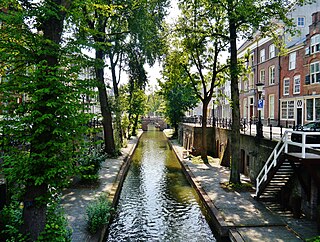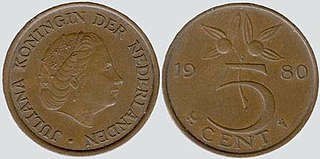
Utrecht is the fourth-largest city and a municipality of the Netherlands, capital and most populous city of the province of Utrecht. It is located in the eastern corner of the Randstad conurbation, and in the very centre of mainland Netherlands, and had a population of 347,574 in 2018.

North Holland is a province of the Netherlands located in the northwestern part of the country. It is situated on the North Sea, north of South Holland and Utrecht, and west of Friesland and Flevoland. In 2015, it had a population of 2,762,163 and a total area of 2,670 km2 (1,030 sq mi).

The Algemeen Dagblad or AD is a Dutch daily newspaper based in Rotterdam, Netherlands.

Football Club Utrecht is a Dutch football club founded on 1 July 1970 and based in the city of Utrecht. The club's colours are red and white.

Friedrich Anton Wilhelm Miquel was a Dutch botanist, whose main focus of study was on the flora of the Dutch East Indies.
The Johan Cruyff Shield is a football trophy in the Netherlands named after Dutch football legend Johan Cruyff, also often referred to as the Dutch Super Cup. The winner is decided in one match only, played by the winner of the national football league and the winner of the national KNVB Cup. In the event of a team winning both the Eredivisie and the KNVB Cup, the Johan Cruyff Shield will be contested between that team and the runner up in the national league. The match traditionally opens the Dutch football season in August one week before the Eredivisie starts.
The Dutch guilder or fl. was the currency of the Netherlands from the 17th century until 2002, when it was replaced by the euro. Between 1999 and 2002, the guilder was officially a "national subunit" of the euro. However, physical payments could only be made in guilder, as no euro coins or banknotes were available. The Netherlands Antillean guilder is still in use in Curaçao and Sint Maarten, but this currency is distinct from the Dutch guilder. In 2004, the Surinamese guilder was replaced by the Surinamese dollar.

The stuiver[stœy.vər] was a pre-decimal coin used in the Netherlands. It was worth 16 penning or 8 duit. Twenty stuivers equalled a guilder. It circulated until the Napoleonic Wars. After the conflict, the Netherlands decimalised its guilder into 100 cents. Two stuivers equalled a dubbeltje - the ten-cent coin.

The Netherlands Antillean guilder is the currency of Curaçao and Sint Maarten, which until 2010 formed the Netherlands Antilles along with Bonaire, Saba, and Sint Eustatius. It is subdivided into 100 cents. The guilder was replaced by the United States dollar on 1 January 2011 on Bonaire, Saba and Sint Eustatius. On Curaçao and Sint Maarten, the Netherlands Antillean guilder was proposed to be replaced by a new currency, the Caribbean guilder, but this has been stalled indefinitely by negotiations over the establishment of a separate central bank for Curaçao.

The duit was a copper Dutch coin worth 2 penning, with 8 duit pieces equal to one stuiver and 160 duit pieces equal to one gulden. In Dutch Indonesia 4 duit pieces were equal to one stuiver. To prevent smuggling, the Dutch East India Company (VOC) ordered special coins with their monogram embossed upon them. Only those pieces were valid in Indonesia. It was once used in the Americas while under Dutch rule.

The rijksdaalder was a Dutch coin first issued by the Republic of the Seven United Netherlands in the late 16th century during the Dutch Revolt. Featuring an armored half bust of William the Silent, rijksdaalder was minted to the Saxon reichsthaler weight standard – 448 grains of .885 fine silver. Friesland, Gelderland, Holland, Kampen, Overijssel, Utrecht, West Friesland, Zeeland, and Zwolle minted armored half bust rijksdaalders until the end of the 17th century.
The rixdollar was the currency of British Ceylon until 1828. It was subdivided into 48 stivers, each of 4 duit. Units called the fanam and larin were also used, worth 4 and 9½ stiver, respectively. The currency derived from the Dutch rijksdaalder and stuiver, although the rijksdaalder was worth 50 stuiver. The rixdollar was replaced by the British pound at a rate of 1 rixdollar = 1 shilling 6 pence.
The gulden was the unit of account of the Dutch East Indies from 1602 under the United East India Company, following Dutch practice first adopted in the 15th century. A variety of Dutch, Spanish and Asian coins were in official and common usage. After the collapse of the VOC at the end of the 18th century, control of the islands reverted to the Dutch government, which issued silver 'Netherlands Indies' gulden and fractional silver and copper coins until Indonesian independence in 1948.

The 2005 FIFA World Youth Championship was the 15th edition of the FIFA World Youth Championship. It took place in the Netherlands between 10 June and 2 July 2005.

An exercitiegenootschap or militia was a military organisation in the 18th century Netherlands, in the form of an armed private organization with a democratically chosen administration, aiming to train the citizens and the lower bourgeoisie in use of muskets. Exercitiegenootschappen were propagated by Joan van der Capellen tot den Pol, who translated an old book (1732) by Andrew Fletcher on arming a nation's citizens and so got the idea from Scotland. He also saw them as necessary due to the serious decline in the existing, Orangist schutterijen.
Stuiver Valley is a high hanging valley, largely ice free, between Mount Circe and Mount Dido on the west and Mount Boreas on the east, in the Olympus Range, Victoria Land. Named by Advisory Committee on Antarctic Names (US-ACAN) in 1997 after Minze Stuiver, geochemist, Quaternary Research Center, University of Washington, Quaternary specialist in dating Antarctic samples with United States Antarctic Research Program (USARP) from 1969 to the time of naming; authority on the glacial history of the McMurdo Sound region and McMurdo Dry Valleys, the location of this valley.
The Turkey national under-20 football team is the national under-20 football team of Turkey and is controlled by the Turkish Football Federation. The team competes in the FIFA U-20 World Cup, which is held every two years. To qualify for this tournament, the team must finish in the top six of the UEFA European Under-19 Football Championship from the previous year.

A dubbeltje is a small former Dutch coin, originally made of silver, with a value of a tenth of a Dutch guilder. The 10-euro-cent coin is currently also called a dubbeltje in the Netherlands.

The Five cent coin was a coin struck in the Kingdom of the Netherlands between 1818 and 2001. Twenty stuivers equalled a Dutch Guilder.
Minze Stuiver is a geochemist who was at the forefront of geoscience research from the 1960s until his retirement in 1998. He helped transform radiocarbon dating from a simple tool for archaeology and geology to a precise technique with applications in solar physics, oceanography, geochemistry, and carbon dynamics. Minze Stuiver’s research encompassed the use of radiocarbon (14C) to understand solar cycles and radiocarbon production, ocean circulation, lake carbon dynamics and archaeology as well as the use of stable isotopes to document past climate changes.












